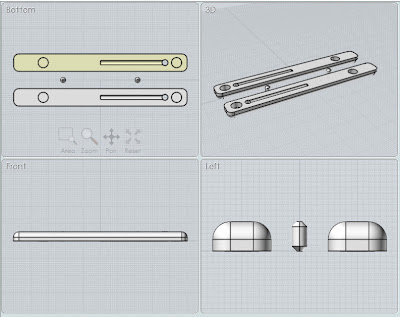Scour the hobbyists and consumer 3D printer sites and blogs and you will see that sooner or later most, if not all, 3D extrusion printers will clog for one reason or another. It comes with the territory.
As more and more 3D printer manufacturers use pre-built hot ends, it becomes less effective to tear a hot end apart to clear the clog. The Cube falls into this category... as does the much more expensive ($17,000-$22,000) HP 3D printer. HP has even published a Support Document that deals with how to clear a clog in their printer.
While it rarely happens, when a Cube's tip becomes clogged, a user has two choices. They can either send the unit back for repair. Or, they can clear the clog themselves. Cube time is so precious to me that I have opted for the latter. And, I want to explain to everyone how I do it.
But, before doing so, we have to say that if you try what I am about to describe that you do so at your own risk. To clear the Printjet tip, it has to be heated and it can cause a nasty burn if we aren't careful. Of course, no child should be allowed to do this. It requires good small muscle control and a steady eye.
WHAT YOU NEED
The most critical item you will need is piano wire that is under .5mm in diameter. I use .38mm piano wire (0.015") that can be found in any hobby store. This wire is inserted into the tip of the hot end to clear it.
HANDLES MAKE IT EASIER
While it is not required to have handles, they certainly make it easier. And, since we have a 3D printer, we can make the type of our choice. In my case, I printed two different types. Since I've not had a clog recently, it's not been possible to test either of them. But, I am certain that both will work well.
SMALL HANDLE
The first style is short and the wire is mounted in the center of the handle. There is a shaft for the wire's exit and a small hole into which the bent end of the wire is inserted.
 |
| Short Handle for Piano Wire |
The reason why the posts are not attached before printing is that it would have required supports for at least one half. The above arrangement, with external posts, allows us to print without supports and still provide a way to ensure perfect alignment of the halves.
Notice that the holes appear to be considerable larger than the diameter of the posts. At print time this difference goes away and the posts and holes are very closely sized. Remember, holes get smaller and posts get larger as we discussed in a previous article.
In like manner, the shaft and hole for the piano wire must be a lot larger than the piano wire's diameter. Otherwise, the hole will close up. Here is an image of the completed small wire handle. A piece of paper is included in the image to help show the wire.
 |
| Finished Piano Wire in Short Handle |
LARGE HANDLE
In the small handle, the wire exits the handle in the middle of the handle. The large handle is designed to be asymmetric so that we can reach in from the side. It may or may not be easier. We'll see if and when we have a clog.
 |
| Long Handle for Piano Wire |
Here is the completed long handle.
 |
| Finished Piano Wire in Long Handle |
HOW TO USE ONE
If I get a clog, I will used the "Install Cartridge" option to heat the Printjet hot end. When I hear the extruder running in reverse to back out the filament, I insert the wire into the tip and hot end and gently press upwards until the wire moves freely up into the print tip about 1/4" to 1/2". This should push the errant filament out of the bottom tube. Or, at least that has been my experience in the two times I've used piano wire in the past.
SAFETY & LIABILITY ISSUES
Normally, I would put the designs up on the Cubify Store. But, liability issues outweigh helpfulness in this particular case. It's not only possible to burn yourself. It's also possible to ruin your Cube unless you are careful. So, I post this article simply to tell you how I deal with the issue and let you decide if you do or do not want to go the same route. Hopefully, NONE of us will need it. But, I want to be prepared, just in case. I don't want to lose a single day of work with my Cube!
NOTE: THE BEST WAY TO AVOID CLOGS
There are two things that I have found will CAUSE a clog.
- The first is to pull the filament out too aggressively when changing cartridges. You do NOT want to break off a piece inside the head. So, be patient and let the machine do the work of reversing the filament.
- The second is not rounding the tip of the new filament before loading.
 |
| Three ways to trim the end of the filament |
The cut on the blue filament is too straight. The edges can bump onto the lip of the bottom tube just below the extrusion wheels.
The cyan filament is cut so that the long tip bends outward. Filament has a natural curve and the tip of the filament cut like this ends up either hanging on the lip of the bottom tube or guiding itself outside the tube altogether.
The best way to trim the end of the filament is to trim it in multiple directions so that the pointed tip is roughly at the center of the filament. Also, make sure that the filament is as straight as possible.










0 nhận xét:
Đăng nhận xét